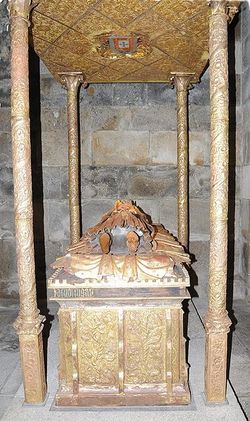At the end of 1400, the royal family went to the province of Minho, for the consecration, by King John I, of the church of Nossa Senhora da Oliveira, in Guimarães, as well as for the celebration of the Courts (January 1401). While the party was still in Braga, the Crown Prince fell ill. And he would end up dying on December 22, 1400, in the city of Braga.
He is buried in the Catedral of Braga, in a mausoleum that art historiography has considered to come from Flanders, supposedly at the behest of his sister Isabel, married to Philip III, the Good Duke of Burgundy. Composed of a tomb ark and a jamb, topped by a canopy (a kind of), the work is unanimously considered unique in European tumularia. The wooden structure is entirely covered with elements of golden and silver copper, with an inscription on it.
At the end of 1400, the royal family went to the province of Minho, for the consecration, by King John I, of the church of Nossa Senhora da Oliveira, in Guimarães, as well as for the celebration of the Courts (January 1401). While the party was still in Braga, the Crown Prince fell ill. And he would end up dying on December 22, 1400, in the city of Braga.
He is buried in the Catedral of Braga, in a mausoleum that art historiography has considered to come from Flanders, supposedly at the behest of his sister Isabel, married to Philip III, the Good Duke of Burgundy. Composed of a tomb ark and a jamb, topped by a canopy (a kind of), the work is unanimously considered unique in European tumularia. The wooden structure is entirely covered with elements of golden and silver copper, with an inscription on it.
Family Members
Advertisement
Advertisement












